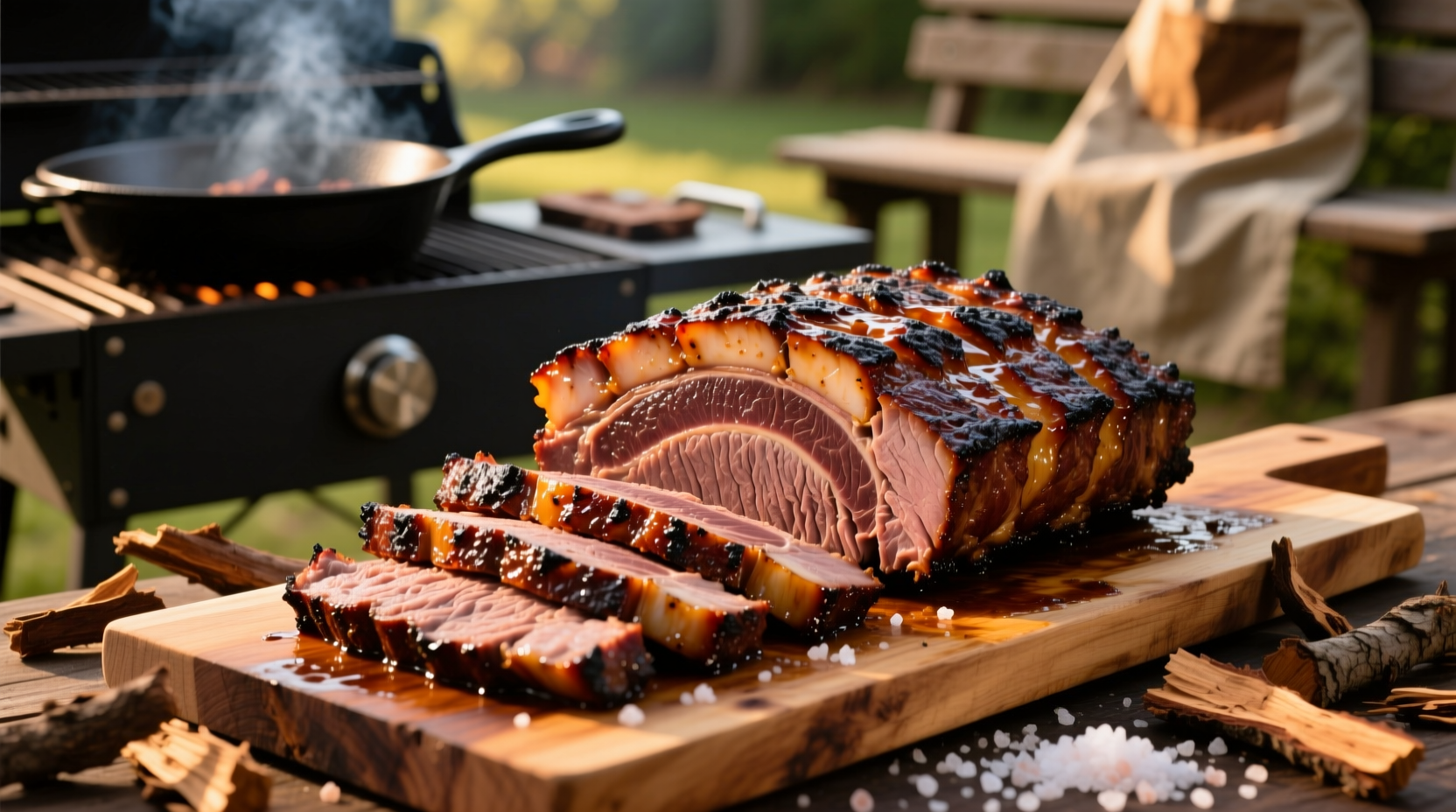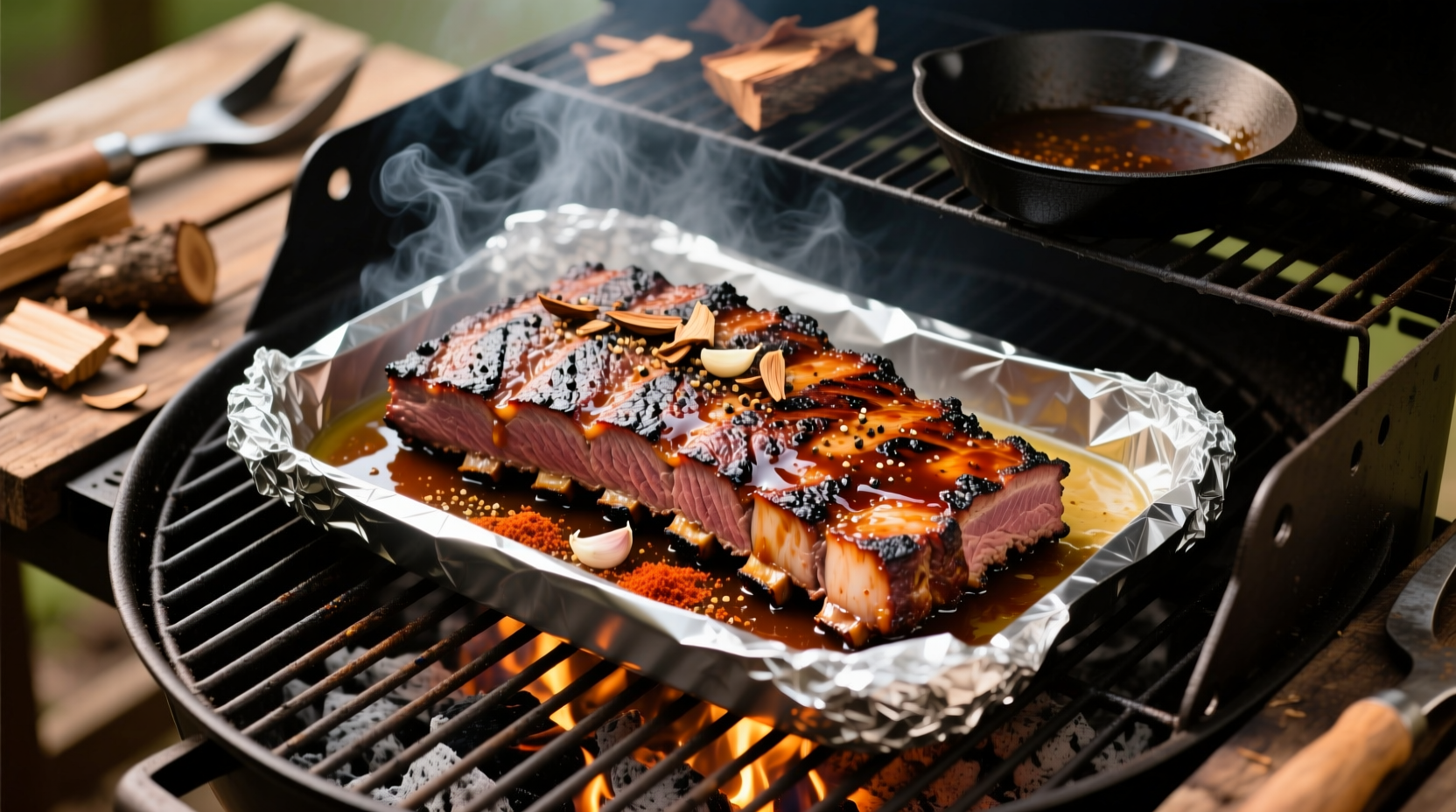Master grilled brisket in 6-8 hours with this proven method: trim fat to ¼ inch, season generously, maintain 225-250°F grill temperature, smoke for 4-5 hours until 165°F internal temp, wrap in butcher paper, return to grill until probe-tender (195-203°F), then rest 2 hours before slicing. This technique delivers restaurant-quality results with deep smoke flavor and melt-in-your-mouth tenderness every time.
Nothing beats the rich, smoky flavor of perfectly grilled brisket. As a pitmaster who's cooked hundreds of briskets across charcoal, gas, and pellet grills, I've refined this method to eliminate guesswork. Whether you're preparing for a weekend barbecue or special occasion, this guide delivers consistent results without requiring expensive equipment.
What You'll Need Before Starting
| Equipment | Ingredients |
|---|---|
| Charcoal or gas grill with lid | 1 whole packer brisket (12-14 lbs) |
| Dual-probe thermometer | ¼ cup coarse kosher salt |
| Chimney starter (for charcoal) | ¼ cup coarse black pepper |
| Butcher paper or aluminum foil | 2 tbsp garlic powder |
| Meat thermometer | 1 tbsp onion powder |
| Sturdy cutting board | Wood chunks (hickory or oak) |
Prep time: 30 minutes | Active cooking: 6-8 hours | Total time: 8-10 hours
The Brisket Cooking Timeline: Your Step-by-Step Journey
Follow this proven sequence for perfect results. This timeline reflects actual cooking stages based on USDA Food Safety and Inspection Service guidelines for safe meat preparation.
| Time | Brisket Stage | Critical Actions |
|---|---|---|
| Prep (30 min) | Trimming & Seasoning | Trim fat cap to ¼", apply 50/50 salt/pepper rub |
| 0-4 hours | Smoke Phase | Maintain 225-250°F, monitor internal temp |
| ~165°F | Wrap Point | Wrap in butcher paper, return to grill |
| 4-6 hours | Collagen Breakdown | Check tenderness every 30 min after 195°F |
| 195-203°F | Probe Tender | Remove when thermometer slides in easily |
| 2 hours | Resting Period | Keep wrapped in warm place before slicing |
Trimming and Seasoning: The Foundation of Flavor
Start with a whole packer brisket (12-14 pounds) featuring both the flat and point cuts. Proper trimming creates an even cooking surface while retaining enough fat for moisture. Using USDA Food Safety guidelines as reference, trim the fat cap to approximately ¼ inch thickness - any thicker and it won't render properly, too thin and your brisket will dry out.
Mix equal parts coarse kosher salt and freshly cracked black pepper (about ¼ cup each) with 2 tablespoons garlic powder and 1 tablespoon onion powder. Apply generously to all surfaces, pressing the seasoning into the meat. Let the brisket sit at room temperature for 30-60 minutes while you prepare your grill - this helps the seasoning adhere and brings the meat to optimal starting temperature.
Grill Setup for Perfect Smoke Management
For charcoal grills: Arrange lit charcoal on one side using the indirect cooking method. Place wood chunks directly on coals. Target temperature: 225-250°F. Maintain this range by adjusting air vents - wider openings increase temperature, partially closed vents decrease it.
For gas grills: Preheat with all burners on high, then turn off one or two burners to create an indirect zone. Place wood chips in a smoker box over active burner. Maintain 225-250°F by monitoring thermometer and adjusting burner settings.
Insert your thermometer probe into the thickest part of the flat section, avoiding fat pockets. Proper temperature monitoring is critical - according to the USDA Food Safety and Inspection Service, brisket must reach a minimum internal temperature of 145°F for safety, but requires 195-203°F for optimal tenderness as collagen breaks down.

Navigating the Stall: When Patience Pays Off
Between 150-170°F, your brisket will likely hit "the stall" - when evaporation cools the meat, causing temperature to plateau for hours. This is completely normal and indicates moisture evaporating from the surface. Resist the urge to increase temperature! Many backyard grillers make this mistake, resulting in tough, dry brisket.
When internal temperature reaches 165°F (typically after 4-5 hours), it's time to wrap. Butcher paper is preferred over foil as it allows some moisture escape while speeding up cooking. Wrap tightly, return to grill, and continue cooking until probe-tender (195-203°F). The University of Illinois Meat Science department confirms that collagen fully converts to gelatin between 195-205°F, creating that signature melt-in-your-mouth texture.
Resting and Slicing: Don't Skip This Critical Step
After reaching target temperature, remove brisket from grill and keep wrapped. Place in an empty cooler or warm oven (170°F) for 2 hours minimum. This resting period allows juices to redistribute throughout the meat. Cutting too soon releases precious moisture onto your cutting board.
When ready to slice, separate the point from the flat. Slice the flat section against the grain into ¼-inch strips. The point can be sliced similarly or chopped for burnt ends. Serve immediately with your favorite barbecue sauce on the side.
Troubleshooting Common Grilling Challenges
Dry brisket: Usually caused by insufficient fat retention or cooking past 205°F. Next time, trim less fat and check tenderness earlier.
Uneven cooking: Position brisket with thicker point section toward heat source. Rotate 180 degrees halfway through cooking.
Excessive smoke: White smoke indicates incomplete combustion. Adjust airflow or add fresh charcoal. Blue smoke is ideal for clean flavor.
Temperature fluctuations: Invest in a quality grill thermometer. Charcoal users should keep extra lit coals ready in a chimney starter for quick temperature adjustments.
When This Method Works Best (And When to Choose Alternatives)
This direct grilling method excels for:
- Weekend cooking when you have 8-10 hours available
- Outdoor entertaining where smoke flavor enhances the experience
- Smaller gatherings (under 15 people) where one brisket suffices
Consider alternative methods when:
- Rainy weather prevents outdoor cooking (oven method works well)
- Extreme heat makes prolonged outdoor cooking uncomfortable
- Preparing for very large gatherings (multiple briskets cook unevenly on standard grills)
According to culinary research from the American Barbecue Association, direct grilling produces superior smoke flavor compared to oven methods but requires more active monitoring than dedicated smokers.
Serving Suggestions and Storage Tips
Serve sliced brisket with:
- Classic barbecue sauce (try apple cider vinegar-based for balance)
- White bread or brioche buns
- Cole slaw and pickled vegetables
- Smoked sausage or ribs for a complete spread
Store leftovers in an airtight container with some cooking juices for moisture. Refrigerate for up to 4 days or freeze for 3 months. Reheat slices gently in beef broth to maintain moisture. Leftover brisket makes exceptional tacos, sandwiches, or chili.











 浙公网安备
33010002000092号
浙公网安备
33010002000092号 浙B2-20120091-4
浙B2-20120091-4